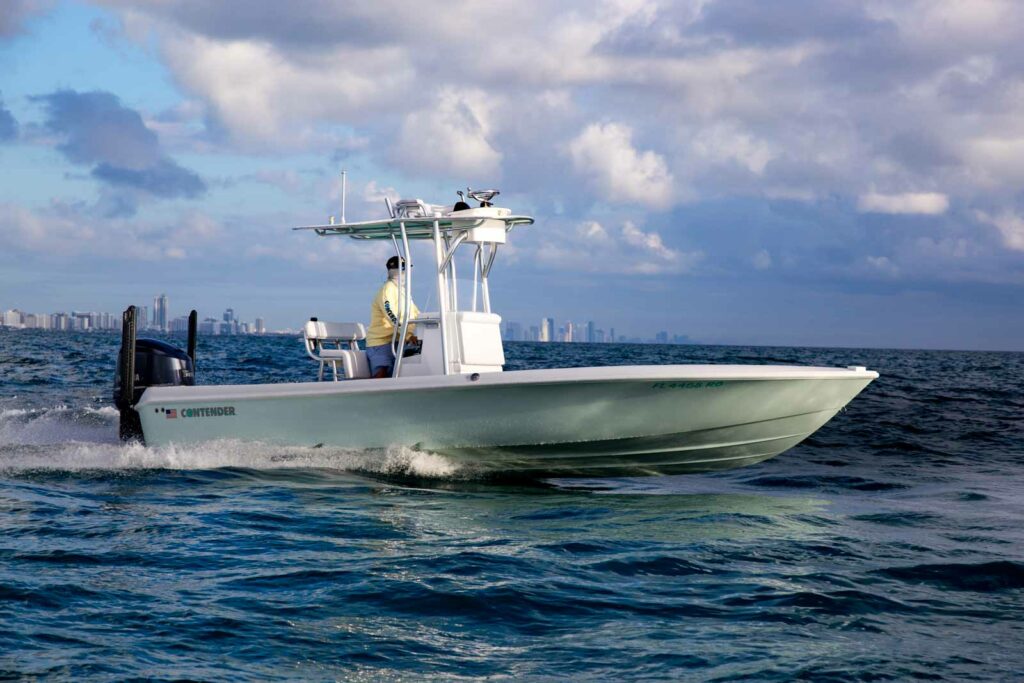
Bay boats occupy a sweet spot in the saltwater fishing world. They're capable enough to handle open water on favorable days, yet shallow-draft enough to chase redfish through skinny backcountry flats. These versatile fishing platforms have evolved significantly over the past few years, with manufacturers blurring traditional boundaries between bay boats, hybrid models, and compact center consoles. Whether you're a serious tournament angler targeting speckled trout in Texas bays or a family looking for a fishing boat that can double as a weekend cruiser, today's bay boats deliver impressive capability across multiple scenarios.
The modern bay boat market offers compelling options from established builders and innovative newcomers alike. Unlike strict rankings that ignore individual priorities, this guide examines eight standout manufacturers whose bay boats represent different approaches to the category. Some emphasize pure fishing functionality with features like multiple livewells and expansive casting decks. Others integrate family-friendly amenities such as convertible seating and entertainment systems. A few push performance boundaries with stepped hulls and aggressive running surfaces designed for serious offshore ventures.
Understanding what separates a quality bay boat from the rest requires looking beyond marketing materials. Hull design, construction methods, standard equipment packages, and dealer support networks all factor into long-term satisfaction. Throughout this analysis, you'll find detailed information on specifications, pricing considerations, and what makes each manufacturer's approach distinctive. For buyers ready to make a purchase, bay boats for sale on Boatzon include comprehensive financing options and delivery coordination that simplifies the buying process.
What Defines Today’s Bay Boats
Bay boats typically measure between 19 and 27 feet, though some manufacturers push past that upper limit. Draft specifications usually range from 12 to 16 inches, allowing access to shallow fishing grounds while maintaining stability in choppier conditions. Beam width has increased across the category over recent years, with many models now sporting 8’6″ to 9’3″ beams that improve stability and create more usable deck space.
These fishing platforms differ from pure flats boats by offering more freeboard, deeper hulls, and greater fuel capacity. Where a technical poling skiff might carry 20 gallons of fuel, bay boats commonly feature 50 to 100-gallon tanks that support longer runs and offshore excursions. The increased freeboard also provides better protection in rough water, though it comes with tradeoffs in wind resistance when poling.
Construction approaches vary by manufacturer, but the trend toward foam-filled hulls, composite stringers, and advanced gelcoat systems reflects buyer expectations for durability and low maintenance. Many premium bay boats now incorporate features once exclusive to larger center consoles: half-towers with elevated helm stations, sophisticated electronics packages, and hydraulic jack plates as standard equipment.

1. Boston Whaler 240 Dauntless Pro
Boston Whaler’s legendary unsinkable construction translates remarkably well to the bay boat category. The 240 Dauntless Pro delivers that signature Whaler ride quality – confident, stable, and reassuringly solid in conditions that would rattle lesser boats. The forward casting deck converts seamlessly to twin loungers when family members come aboard, addressing the versatility requirement that many bay boat buyers prioritize.
What sets this model apart is the available half-tower configuration with a fully functional second helm station. Most bay boats in this size range don’t offer genuine upper helm controls, settling instead for simple observation platforms. The 240 Dauntless Pro’s tower station includes throttle, steering, and electronics integration that makes it truly usable for sight fishing or navigating through no-wake zones while other anglers work the deck below.
The hull measures 23’11” with an 8’6″ beam and draws just 11 inches with the drive trimmed up. Power options extend up to twin 150hp outboards, though single-engine configurations are more common. Fuel capacity sits at 90 gallons, providing excellent range for offshore runs. Expect pricing to start around $135,000 for a well-equipped model, positioning this as a premium option in the bay boat segment.
Boston Whaler’s construction uses their proprietary Unibond process, which permanently bonds the hull liner to the deck, creating a virtually unsinkable structure. This manufacturing approach adds weight compared to some competitors but delivers peace of mind that resonates with safety-conscious buyers. The trade-off shows up in performance, as the 240 Dauntless Pro runs efficiently but won’t match the hole shot of lighter, performance-oriented designs.
Standard equipment is generous, including a leaning post with rod storage, in-deck fish boxes, and integrated livewell systems. The cockpit layout provides excellent sight lines from the helm, while rod storage accommodates up to 12 rods depending on configuration. For families who fish occasionally but also want a comfortable coastal cruising platform, the Dauntless Pro delivers impressive versatility without major compromises in either direction.
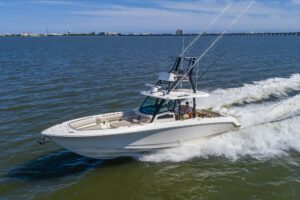
2. Pathfinder 2500 Hybrid
Pathfinder has built its reputation around serious fishing boats that don’t pretend to be anything else. The 2500 Hybrid exemplifies this approach. It’s a fishing machine first, with family features integrated thoughtfully rather than prioritized over angling capability. The forward casting deck offers exceptional space for working topwater lures or fly fishing, while the open cockpit layout keeps deck clutter to a minimum.
This model’s half-tower design puts anglers at ideal height for spotting tailing redfish or cruising cobia. The elevated helm position transforms shallow-water fishing strategies, allowing you to see fish and structure that would remain invisible from a standard helm. The tower’s construction is robust enough for rough water, not just calm-day sight fishing in protected bays.
Measuring just over 25 feet with an 8’6″ beam, the 2500 Hybrid draws only 13 inches despite its substantial build. This shallow draft comes from a carefully engineered hull bottom that balances draft with stability. The hull’s modified-V configuration runs confidently in choppy bay conditions and has proven capable in nearshore Gulf waters when weather windows allow. Pathfinder offers multiple power options, with many buyers choosing single 300hp or twin 150hp configurations.
Pricing starts around $110,000 for basic packages, though most buyers add options that push the final number higher. The investment reflects Pathfinder’s hand-laid construction process and attention to structural details. Unlike production boats built on assembly lines, Pathfinders receive individual attention throughout the build process, resulting in fit and finish that exceeds many competitors.
Storage solutions include a large forward fish box, in-deck cooler space, and multiple rod holders positioned strategically around the gunwales and console. The leaning post integrates tackle storage and additional rod holders, keeping essential gear accessible without cluttering the deck. Pathfinder’s approach to livewell design emphasizes water flow and oxygenation. These are critical details that tournament anglers appreciate during summer months when keeping bait alive becomes challenging.
3. Barker Boatworks 26 Open
Barker Boatworks represents the boutique end of the bay boat market, building limited numbers of custom-oriented vessels that blur categories. The 26 Open generates debate about whether it qualifies as a bay boat or a small center console. This discussion misses the point of what makes this platform compelling. It combines shallow-draft capability with genuine offshore competence, creating unusual versatility for buyers who refuse to compromise on either capability.
The 9’3″ beam stands out immediately when you step aboard. This extra width compared to traditional bay boats creates stability that inspires confidence in rough conditions. The hull’s aggressive Carolina flare sheds water effectively, keeping the deck drier than you’d expect from a boat with such shallow draft. At 14 inches, the draft specification allows access to productive backcountry zones while the substantial freeboard and beam enable comfortable passages through offshore chop.
Barker’s reputation rests on hand-crafted construction quality that rivals custom sportfish builders. The attention to detail shows in composite work, through-hull installations, and hardware selection. Everything is overbuilt to a degree that feels excessive until you experience how the boat performs in challenging conditions. Where production boats might flex or transmit hull slap, the 26 Open remains rigid and quiet.
The livewell system exemplifies Barker’s fishing-first philosophy. It includes a 45-gallon well in the leaning post for live bait and a 15-gallon bow well positioned for quick access when rigging lines. This thoughtful placement reflects real fishing experience rather than just checking boxes on a feature list. The available half-tower configuration matches the execution found on boats twice the price, with solid construction and intuitive control placement.
Expect pricing to start around $185,000, making this one of the more expensive options in the bay boat category. The cost reflects custom-level build quality and the hand-laid construction process. For buyers who want a fishing platform that will last decades rather than years, Barker’s approach justifies the premium. Production numbers remain limited, so ordering often involves waiting several months for build slots.
Finance your Barker Boatworks today
4. Tidewater 2210 Carolina Bay
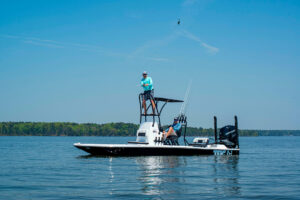
Tidewater entered the market in 2006 with a value-focused strategy that hasn’t compromised quality. The 2210 Carolina Bay represents their approach particularly well. It delivers essential fishing features and solid construction at price points that make boat ownership accessible to more buyers. While premium manufacturers emphasize exotic materials and complex hull designs, Tidewater focuses on proven construction methods and practical layouts.
The 2210 spans just over 22 feet with an 8’2″ beam, creating a footprint that’s trailerable behind most SUVs and fits in standard storage spaces. The forward casting deck provides adequate space for two anglers, though it’s sized more conservatively than premium competitors. This restraint actually benefits rough-water performance, keeping weight distribution balanced and the bow from slamming in chop.
Livewell capacity impresses given the boat’s size and price point. Twin wells offer flexibility for keeping different bait species separated or dedicating one to the day’s catch. The wells feature rounded corners that improve water circulation and prevent bait from getting trapped in dead spots. These details separate functional designs from afterthought implementations.
Starting prices around $65,000 make the 2210 Carolina Bay one of the more affordable new bay boats from a reputable manufacturer. This positions it well for first-time buyers or anglers stepping up from aluminum boats. The value proposition extends beyond initial purchase price. Tidewater’s relatively simple systems and widespread dealer network help control long-term ownership costs.
Power options typically range from 150hp to 200hp outboard configurations. The hull’s moderate deadrise and traditional design doesn’t push performance boundaries but delivers predictable handling characteristics. For buyers prioritizing fishing functionality over speed records, this conservative approach makes sense. The boat reaches plane quickly, runs efficiently at cruise speeds, and handles bay chop without drama.
Shop Tidewater Boats for sale on Boatzon
5. Contender 25 Bay
Contender’s legacy in the center console market brings credibility to their bay boat offerings. The 25 Bay applies lessons learned building offshore tournament machines to a shallow-water platform, resulting in construction quality that exceeds category standards. This isn’t a center console with lower freeboard. It’s a purpose-built bay boat that happens to incorporate Contender’s meticulous build processes.
The hull stretches 25 feet with an 8’6″ beam and draws just 12 inches with the drive trimmed up. These specifications allow confident navigation through shallow coastal areas while maintaining the stability needed for comfortable fishing in Texas bays or Louisiana marshes. The modified-V hull includes aggressive strakes that enhance lift and improve stability at rest. These are important characteristics when multiple anglers are moving around the deck.
Contender’s approach to bay boats includes luxury appointments that you might not expect in a fishing platform. The helm features comfortable seating with bolster options, quality instrumentation, and thoughtful storage solutions. Forward seating converts between fishing and cruising configurations, allowing the boat to transition from tournament fishing to family outings without feeling compromised in either role.
The optional T-top installation showcases Contender’s commitment to integration rather than afterthought additions. The hardtop mounts solidly to the console and gunwales, eliminating the flex and noise common with bolt-on alternatives. Electronics boxes, spreader lights, and rod holders are incorporated into the design rather than added as accessories, resulting in clean lines and superior functionality.
Pricing starts around $145,000 for well-equipped examples, reflecting Contender’s premium positioning. The cost includes construction details like composite stringers, foam-filled hull cavities, and hardware that won’t corrode after a season in saltwater. For buyers who view boats as long-term investments rather than disposable recreation equipment, Contender’s build quality justifies the upfront expense through reduced maintenance and better resale values.
6. Caymas 25 HB
Caymas burst onto the bay boat scene with performance-oriented designs that challenged established manufacturers to improve their offerings. The 25 HB (Hybrid Bay) features Michael Peters’s patented stepped-vee tunnel hull design, creating lift and efficiency that translates to impressive performance numbers. This isn’t just marketing. The hull’s design produces measurably better fuel economy and higher top speeds than conventional bottoms of similar displacement.
The 9-foot beam provides exceptional stability, whether you’re fighting fish at the gunwales or running through choppy conditions. This width also creates interior volume that Caymas maximizes through clever deck layouts. Storage compartments are sized for real fishing gear rather than dimensioned to fit arbitrary spaces, reflecting input from tournament anglers during the design process.
Forward seating converts smoothly between fishing and entertainment configurations. When you need casting space, the seats fold out of the way completely. When family members want to relax, the seating areas provide comfortable lounging with proper cushioning and back support. This dual-use capability works better than competing designs that compromise both functions in pursuit of versatility.
The stepped hull design does produce a distinctive sound at certain RPM ranges. This is a trait common to stepped-bottom boats that some buyers find objectionable and others don’t notice. Test drives should include running at various speeds to determine whether this characteristic bothers you. The performance advantages are substantial enough that most buyers accept the acoustics as a reasonable trade-off.
Pricing starts around $155,000 for the 25 HB with standard equipment packages. That positions Caymas in the premium segment alongside Contender and above Tidewater, reflecting the stepped-hull technology and quality construction. The company’s growth over recent years has expanded dealer networks considerably, improving parts availability and service access compared to earlier years when finding knowledgeable techs required more effort.
7. Everglades 253 CC
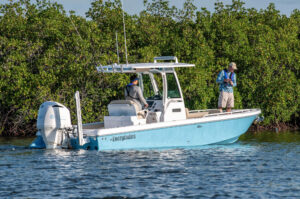
Everglades approaches bay boats from a center console perspective, and the 253 CC reflects that heritage. The designation includes “CC” (center console) intentionally. Everglades views this as a crossover platform that delivers bay boat draft with center console offshore capability. The completely redesigned hull balances these competing requirements more successfully than previous generations, creating a genuinely versatile fishing platform.
The 8’6″ beam and 16-inch draft represents the deepest specification in this comparison, trading some shallow-water access for improved rough-water performance. This makes sense for anglers who spend more time running offshore than working skinny flats. The hull’s construction includes RAMCAP technology that improves impact resistance and structural integrity. This is particularly valuable when navigating rock-strewn passes or bouncing through Gulf chop.
Forward seating is exceptionally comfortable, with cushioning quality that rivals purpose-built cruisers. The layout works well for families who fish occasionally but primarily use the boat for coastal exploration and watersports. Anglers can remove cushions to access storage below or create open deck space when serious fishing demands it. This flexibility appears throughout the design, allowing owners to optimize layouts for specific trips rather than accepting a single compromise configuration.
Everglades manufactures in Florida with construction processes refined over decades. The brand’s reputation for durability comes from meticulous lamination schedules, quality resin systems, and gelcoat that resists the brutal UV exposure common in southern climates. These details aren’t immediately visible but become apparent over years of ownership through better appearance retention and fewer structural issues.
Expect pricing around $165,000 for well-equipped models. The premium reflects Everglades’ construction quality and the inclusion of features that competitors often charge extra for installing. The company’s dealer network concentrates in traditional sportfishing markets, providing excellent service access in coastal areas where these boats see the most use.
Shop Everglades by Dougherty on Boatzon
8. Yellowfin 21 Bay
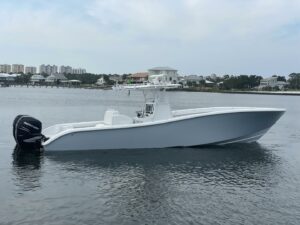
Yellowfin’s reputation for beautiful hulls and exceptional center consoles extends to their bay boat offerings. The 21 Bay represents the smaller end of this comparison, appealing to anglers who prioritize maneuverability and speed over maximum deck space. At just over 21 feet with a 7’9″ beam, this model fits garages and narrow launch ramps that would exclude larger alternatives.
The compact dimensions don’t sacrifice fishing capability. Three separate livewells provide flexibility for managing different bait species or keeping fish segregated. The wells are properly sized and incorporate design details that promote water circulation. This is critical during summer months when water temperatures climb and oxygen levels plummet. Yellowfin’s attention to these functional details separates their execution from competitors who view livewells as commodity features.
Performance is exceptional. The hull design and lightweight construction combine to produce 50+ mph top speeds with appropriate power, while fuel consumption remains reasonable at cruise settings. The 50-gallon fuel tank provides adequate range for most inshore and nearshore fishing scenarios. Hole shot is impressive, getting anglers to fishing spots quickly and allowing rapid repositioning when working moving schools of gamefish.
The layout emphasizes fishing over entertainment, with minimal seating and maximum open deck space. This makes sense given the boat’s size. Trying to incorporate extensive seating in a 21-footer compromises fishing functionality without creating genuinely comfortable lounging areas. Yellowfin’s approach recognizes this reality and designs specifically for serious anglers rather than trying to appeal to every potential buyer.
Pricing starts around $95,000 for standard configurations. That positions the 21 Bay as a premium option among smaller bay boats while remaining less expensive than 24-26 foot competitors. The value proposition centers on construction quality and performance rather than maximum interior volume. For anglers who don’t need space for large groups, Yellowfin’s execution in this size range is difficult to beat.
Shop Yellowfin Yachts for sale
Choosing the Right Bay Boat for Your Fishing Style
Selecting among these manufacturers requires honest assessment of how you’ll actually use the boat. Anglers who fish tournaments or make frequent offshore runs benefit from boats like the Caymas 25 HB or Barker 26 Open that prioritize performance and offshore capability. Families who fish occasionally but want versatile entertainment platforms will appreciate the Everglades 253 CC or Boston Whaler 240 Dauntless Pro, which integrate comfortable seating without sacrificing essential fishing features.
Budget considerations obviously influence decisions, but focusing solely on purchase price overlooks important factors. Construction quality affects long-term maintenance costs, resale values, and overall ownership satisfaction. A $65,000 Tidewater that requires frequent repairs or depreciates rapidly may ultimately cost more than a $145,000 Contender that runs trouble-free and retains value. Similarly, fuel efficiency differences between hulls can represent thousands of dollars annually for anglers who run 50+ days per season.
Geographic location matters more than many buyers initially recognize. Boats designed for Texas bays may be overbuilt for calmer Southeast Florida waters, while hulls optimized for protected areas might feel uncomfortable in the Louisiana marsh where afternoon winds create challenging conditions. Local dealer support also factors into ownership experience – purchasing a boat that requires traveling several states for warranty service creates frustrations that offset any initial savings.
Financing and Purchasing Considerations
The bay boat market’s price range spans from approximately $65,000 to $185,000+ for the models discussed here. Financing options have improved significantly over recent years, with marine lenders offering terms that make ownership accessible to more buyers. Interest rates vary based on credit profiles and down payment amounts, but competitive rates are available for well-qualified buyers.
Boat financing options through platforms like Boatzon streamline the approval process and often provide better rates than manufacturer-direct financing. The advantage comes from lenders competing for your business rather than accepting whatever terms a single finance company offers. Pre-approval also strengthens your negotiating position with dealers, who know you’re a serious buyer with verified funding.
Trade-in values for current boats affect net purchase costs substantially. The used boat market has softened from pandemic-era peaks but remains stronger than historical averages. Dealers actively seek quality used inventory, creating opportunities for favorable trade valuations. Getting multiple trade quotes before committing to a purchase reveals which dealers are motivated to earn your business through competitive offers.
Insurance costs vary considerably based on boat value, usage patterns, and coverage limits. Bay boats that venture offshore regularly may face higher premiums than boats restricted to protected waters. Installing tracking devices or completing boater safety courses can reduce insurance expenses in many cases. Obtaining insurance quotes before finalizing purchases prevents surprises and ensures you understand total ownership costs.
Frequently Asked Questions
What’s the difference between a bay boat and a center console?
Bay boats emphasize shallow draft and interior layouts optimized for sight fishing and working protected waters. They typically feature lower freeboard, wider beams relative to length, and tunnel hulls or modified-V bottoms that reduce draft. Center consoles prioritize offshore capability with deeper V-hulls, higher freeboard, and larger fuel capacities. The distinction has blurred considerably as manufacturers create “hybrid” models that incorporate characteristics of both categories. Modern bay boats like the Barker 26 Open or Everglades 253 CC deliver genuine offshore capability while maintaining shallow-water access, making category definitions less meaningful than specific capability assessments.
How shallow can bay boats run safely?
Most bay boats in the 24-26 foot range draw 12-16 inches with engines trimmed up, allowing navigation through surprisingly shallow water. Smaller models like the Yellowfin 21 Bay may draw slightly less. Running safely in shallow water requires understanding more than static draft specifications, as hull speed, weight distribution, and bottom conditions all affect minimum safe depth. Experienced boaters generally maintain at least 6-12 inches of water under the hull at running speeds to avoid groundings. Poling or idling in even shallower water is possible but demands constant attention to depth changes and bottom composition.
Are bay boats suitable for offshore fishing?
Many modern bay boats handle nearshore and offshore conditions surprisingly well on favorable weather days. Models with 8’6″ or wider beams, substantial freeboard, and properly designed hulls venture offshore confidently when conditions allow. However, “offshore” means different things in different regions. Running five miles out in calm Southeast Florida waters differs dramatically from navigating Louisiana’s Gulf passes in afternoon chop. Bay boats lack the fuel capacity for extended offshore runs that larger center consoles handle routinely. They also offer less protection from spray and breaking waves than true offshore platforms. Realistic assessments of typical weather windows and sea conditions in your area should guide expectations about offshore capability.
What maintenance do bay boats require?
Saltwater boat maintenance focuses on preventing corrosion, managing engine health, and protecting gelcoat and canvas from UV damage. After each saltwater use, flush the engine thoroughly with fresh water and rinse the entire boat to remove salt deposits. Monthly maintenance includes checking hull and deck fittings for corrosion, inspecting through-hulls and seacocks, and cleaning livewell systems. Annual service should cover full engine maintenance, trailer bearing inspection and repacking, sacrificial anode replacement, and detailed canvas and upholstery cleaning. Quality bay boats with proper maintenance routinely provide 15-20 years of reliable service. Neglected maintenance accelerates corrosion and deterioration substantially, creating expensive repairs that exceed the cost of preventive care.
Which bay boat manufacturers have the best resale value?
Boston Whaler, Yellowfin, and Pathfinder consistently maintain strong resale values due to construction quality and brand reputation. Contender and Everglades also hold value well, particularly in sportfishing-focused markets. Resale values depend heavily on boat condition, maintenance history, and regional demand. Bay boats maintained meticulously and serviced regularly by qualified technicians command premiums over similar boats with incomplete service records. Geographic factors matter too. Pathfinder and Tidewater models sell particularly well in Texas and Louisiana markets where shallow-draft capability is prioritized, while Everglades and Contender perform better in Florida markets where offshore capability receives more emphasis.
Can bay boats be used in freshwater?
Bay boats function perfectly well in freshwater environments, though their design characteristics aren’t optimized for typical freshwater fishing scenarios. The shallow draft that excels in saltwater flats doesn’t provide significant advantages on most lakes and rivers. The open layouts prioritize saltwater fishing techniques like working live bait and casting topwater lures rather than freshwater approaches like bass tournament fishing. Some buyers do use bay boats on large reservoirs or coastal rivers where draft and deck space offer benefits. Maintenance requirements are actually simpler in freshwater since corrosion concerns are eliminated, though proper post-use procedures still matter for engine longevity.
What size outboard is appropriate for a 25-foot bay boat?
Most 25-foot bay boats perform well with 250-300hp single outboards or twin 150hp configurations. Single engines offer simplicity, reduced maintenance costs, and more cockpit space, while twins provide redundancy and better handling characteristics in some situations. Manufacturer recommendations should guide minimum power requirements, as underpowering creates safety issues and poor performance. Maximum power ratings also deserve respect. Exceeding rated capacity voids warranties and potentially compromises structural integrity. Modern four-stroke outboards deliver impressive fuel efficiency compared to older technologies, making larger engines more practical from an operating cost perspective than previous generations might assume.
How much does it cost to maintain a bay boat annually?
Annual maintenance costs vary significantly based on usage patterns, storage methods, and whether you handle routine tasks yourself or pay marinas. Budget approximately $3,000-$5,000 annually for basic maintenance including engine service, trailer maintenance, bottom paint (if wet-stored), and routine cleaning supplies. Add insurance costs of $800-$1,500 depending on boat value and coverage levels. Fuel represents the largest variable cost. Anglers running 50 days annually might spend $3,000-$6,000 on fuel depending on boat efficiency and run distances. Storage adds $2,000-$8,000 yearly depending on whether you keep the boat at home, in dry storage, or at a wet slip. Total annual ownership costs often range from $8,000-$20,000 when including all expenses.
Conclusion
The bay boat category offers exceptional variety, accommodating buyers from budget-conscious first-time owners to experienced anglers seeking premium fishing platforms. Each manufacturer discussed here brings distinct strengths. Tidewater delivers value, Barker provides custom-level construction, Caymas emphasizes performance, and Yellowfin focuses on fishing functionality in a compact package. The right choice depends on individual priorities, typical usage patterns, and honest assessment of which compromises you’re willing to accept.
For buyers ready to move forward, exploring available bay boats through Boatzon provides access to comprehensive listings, integrated financing solutions, and delivery coordination that simplifies the purchase process. Whether you’re targeting your first bay boat or upgrading from a previous model, these eight manufacturers represent the category’s strongest options for 2025.
Disclaimer: Pricing, specifications, and model availability mentioned in this article reflect information current as of publication and may change without notice. Buyers should verify details directly with manufacturers or authorized dealers before making purchase decisions. Boatzon is not affiliated with the manufacturers discussed and provides this information for educational purposes. Operating boats involves inherent risks. Always follow safety guidelines, obtain proper training, and comply with local regulations.

